warning JEEP GLADIATOR 2023 Service Manual
[x] Cancel search | Manufacturer: JEEP, Model Year: 2023, Model line: GLADIATOR, Model: JEEP GLADIATOR 2023Pages: 448, PDF Size: 17.37 MB
Page 79 of 448
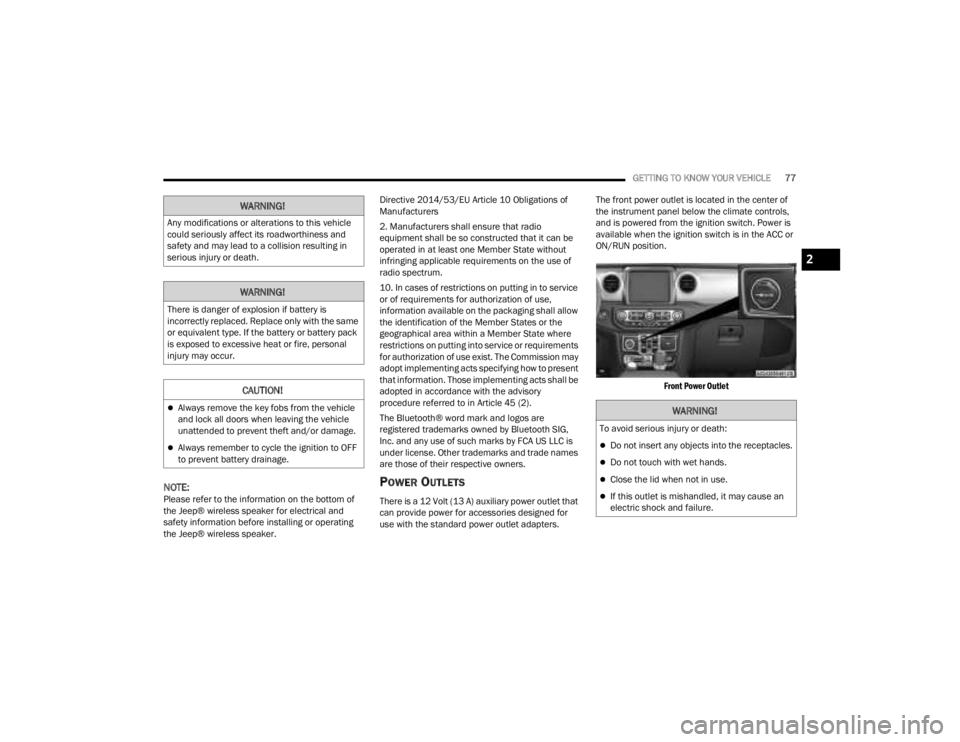
GETTING TO KNOW YOUR VEHICLE77
NOTE:Please refer to the information on the bottom of
the Jeep® wireless speaker for electrical and
safety information before installing or operating
the Jeep® wireless speaker. Directive 2014/53/EU Article 10 Obligations of
Manufacturers
2. Manufacturers shall ensure that radio
equipment shall be so constructed that it can be
operated in at least one Member State without
infringing applicable requirements on the use of
radio spectrum.
10. In cases of restrictions on putting in to service
or of requirements for authorization of use,
information available on the packaging shall allow
the identification of the Member States or the
geographical area within a Member State where
restrictions on putting into service or requirements
for authorization of use exist. The Commission may
adopt implementing acts specifying how to present
that information. Those implementing acts shall be
adopted in accordance with the advisory
procedure referred to in Article 45 (2).
The Bluetooth® word mark and logos are
registered trademarks owned by Bluetooth SIG,
Inc. and any use of such marks by FCA US LLC is
under license. Other trademarks and trade names
are those of their respective owners.
POWER OUTLETS
There is a 12 Volt (13 A) auxiliary power outlet that
can provide power for accessories designed for
use with the standard power outlet adapters.
The front power outlet is located in the center of
the instrument panel below the climate controls,
and is powered from the ignition switch. Power is
available when the ignition switch is in the ACC or
ON/RUN position.
Front Power Outlet
WARNING!
Any modifications or alterations to this vehicle
could seriously affect its roadworthiness and
safety and may lead to a collision resulting in
serious injury or death.
WARNING!
There is danger of explosion if battery is
incorrectly replaced. Replace only with the same
or equivalent type. If the battery or battery pack
is exposed to excessive heat or fire, personal
injury may occur.
CAUTION!
Always remove the key fobs from the vehicle
and lock all doors when leaving the vehicle
unattended to prevent theft and/or damage.
Always remember to cycle the ignition to OFF
to prevent battery drainage.
WARNING!
To avoid serious injury or death:
Do not insert any objects into the receptacles.
Do not touch with wet hands.
Close the lid when not in use.
If this outlet is mishandled, it may cause an
electric shock and failure.
2
23_JT_OM_EN_USC_t.book Page 77
Page 81 of 448
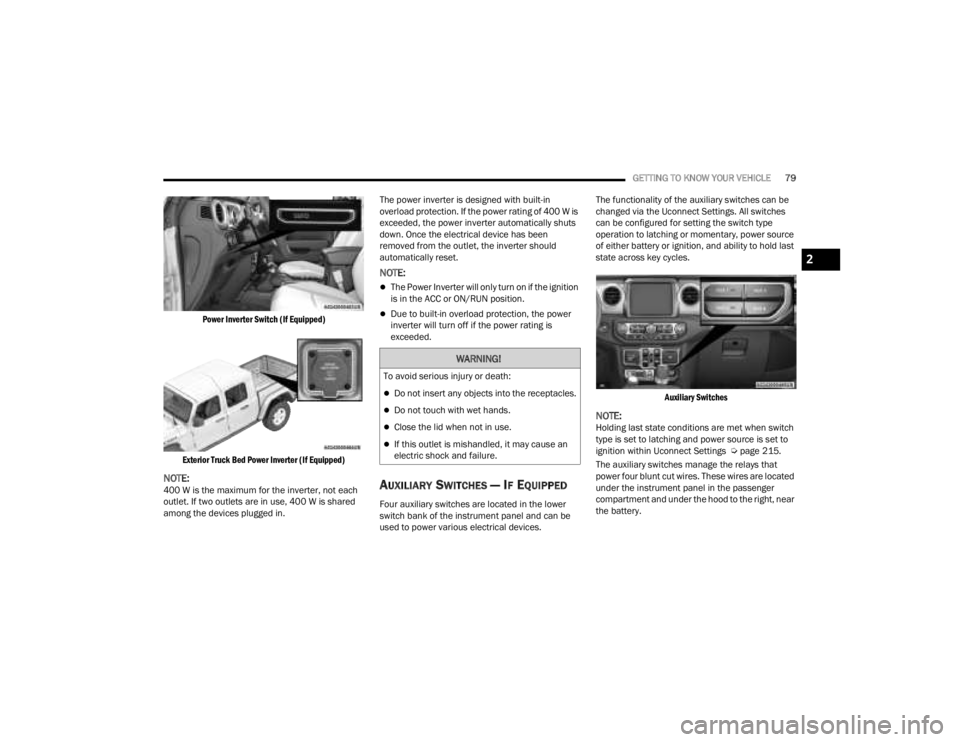
GETTING TO KNOW YOUR VEHICLE79
Power Inverter Switch (If Equipped)
Exterior Truck Bed Power Inverter (If Equipped)
NOTE:400 W is the maximum for the inverter, not each
outlet. If two outlets are in use, 400 W is shared
among the devices plugged in. The power inverter is designed with built-in
overload protection. If the power rating of 400 W is
exceeded, the power inverter automatically shuts
down. Once the electrical device has been
removed from the outlet, the inverter should
automatically reset.
NOTE:
The Power Inverter will only turn on if the ignition
is in the ACC or ON/RUN position.
Due to built-in overload protection, the power
inverter will turn off if the power rating is
exceeded.
AUXILIARY SWITCHES — IF EQUIPPED
Four auxiliary switches are located in the lower
switch bank of the instrument panel and can be
used to power various electrical devices.The functionality of the auxiliary switches can be
changed via the Uconnect Settings. All switches
can be configured for setting the switch type
operation to latching or momentary, power source
of either battery or ignition, and ability to hold last
state across key cycles.
Auxiliary Switches
NOTE:Holding last state conditions are met when switch
type is set to latching and power source is set to
ignition within Uconnect Settings Ú page 215.
The auxiliary switches manage the relays that
power four blunt cut wires. These wires are located
under the instrument panel in the passenger
compartment and under the hood to the right, near
the battery.
WARNING!
To avoid serious injury or death:
Do not insert any objects into the receptacles.
Do not touch with wet hands.
Close the lid when not in use.
If this outlet is mishandled, it may cause an
electric shock and failure.
2
23_JT_OM_EN_USC_t.book Page 79
Page 83 of 448

GETTING TO KNOW YOUR VEHICLE81
POWER WINDOWS — IF EQUIPPED
The power windows feature allows for movement
of the windows with the push of a button. The
power window switches are located on the
instrument panel below the climate controls. Push
the switch downward to open the window and pull
upward to close the window.
The top left switch controls the left front window
and the top right switch controls the right front
window. The bottom left switch controls the left
rear window and the bottom right switch controls
the right rear window.
Power Window Switches
NOTE:
The power window switches will remain active
for up to 10 minutes after the ignition is placed
in the OFF position. Opening either front door
will cancel this feature.
There are window switches located on the rear
of the center console for the rear passenger
windows.
AUTO-DOWN FEATURE
The driver door power window switch and the front
passenger door power window switch have an
Auto-Down feature. Push the window switch down,
past the detent, and release and the window will go
down automatically.To open the window part way, push the window
switch down briefly, without going past the detent,
and release it when you want the window to stop.
To stop the window from going all the way down
during the Auto-Down operation, pull up on the
switch briefly.
MANUAL SLIDING REAR WINDOW —
I
F EQUIPPED
To open the rear sliding window, push the release
button inward while sliding the window into the
open position.
Release Button Location
WARNING!
Never leave children unattended in a vehicle,
and do not let children play with power windows.
Do not leave the key fob in or near the vehicle, or
in a location accessible to children. Occupants,
particularly unattended children, can become
entrapped by the windows while operating the
power window switches. Such entrapment may
result in serious injury or death.
WARNING!
There is no anti-pinch protection when the
window is almost closed. Be sure to clear all
objects from the window before closing.
2
23_JT_OM_EN_USC_t.book Page 81
Page 85 of 448

GETTING TO KNOW YOUR VEHICLE83
(Continued)
LOWERING THE SOFT TOP
Use this QR code to access your
digital experience. If the temperature is below 72°F (24°C) and/or
the top has been folded down for a period of time,
the top will appear to have shrunk when you raise
it, making it difficult to put up. This is caused by a
natural contraction of the vinyl or acrylic materials
of the fabric top.
Place the vehicle in a warm area. Pull steadily on
the top fabric. The vinyl will stretch back to its
original size and the top can then be installed. If
the temperature is 41°F (5°C) or below, do not
attempt to put the top down or roll the rear or side
curtains.
WARNING!
Do not drive the vehicle with the rear window
up/removed unless the quarter windows are
also removed. Dangerous exhaust gases
could enter the vehicle causing harm to the
driver and passengers.
The fabric quarter windows and fabric top are
designed only for protection against the
elements. Do not rely on them to contain occu -
pants within the vehicle or to protect against
injury during an accident. Remember, always
wear seat belts.
Make sure hands and fingers are clear of all
pinch points when installing and removing the
soft top. The lift assist mechanism and side
bows may cause serious injury if fingers or
hands get caught in between.
CAUTION!
The soft top is not designed to carry any
additional loads such as roof racks, spare tires,
building, hunting or camping supplies, and/or
luggage, etc. Also, it was not designed as a
structural member of the vehicle and, thus,
cannot properly carry any additional loads other
than environmental (rain, snow, etc.).
CAUTION!
Do not run a fabric top through an automatic
car wash. Window scratches and wax buildup
may result.
Do not lower the top when the temperature is
below 41°F (5°C). Damage to the top may
result.
Do not move your vehicle until the top has been
either fully attached to the windshield frame, or
fully lowered.
Follow the proper steps for cleaning and caring
for your vehicle’s fabric top
Ú
page 413.
Do not use any tools (screwdrivers, etc.) to pry
or force any of the clamps, clips, or retainers
securing the soft top. Do not force or pry the soft
top framework when opening or closing.
Damage to the top may result.
Failure to follow these cautions may cause interior
water damage, stains, or mildew on the top
material:
It is recommended that the top be free of water
prior to opening it. Operating the top, opening a
door or lowering a window while the top is wet
may allow water to drip into the vehicle's interior.
Careless handling and storage of the soft top
may damage the seals, causing water to leak
into the vehicle's interior.
The soft top must be positioned properly to
ensure sealing. Improper installation can cause
water to leak into the vehicle's interior.
CAUTION!
2
23_JT_OM_EN_USC_t.book Page 83
Page 103 of 448
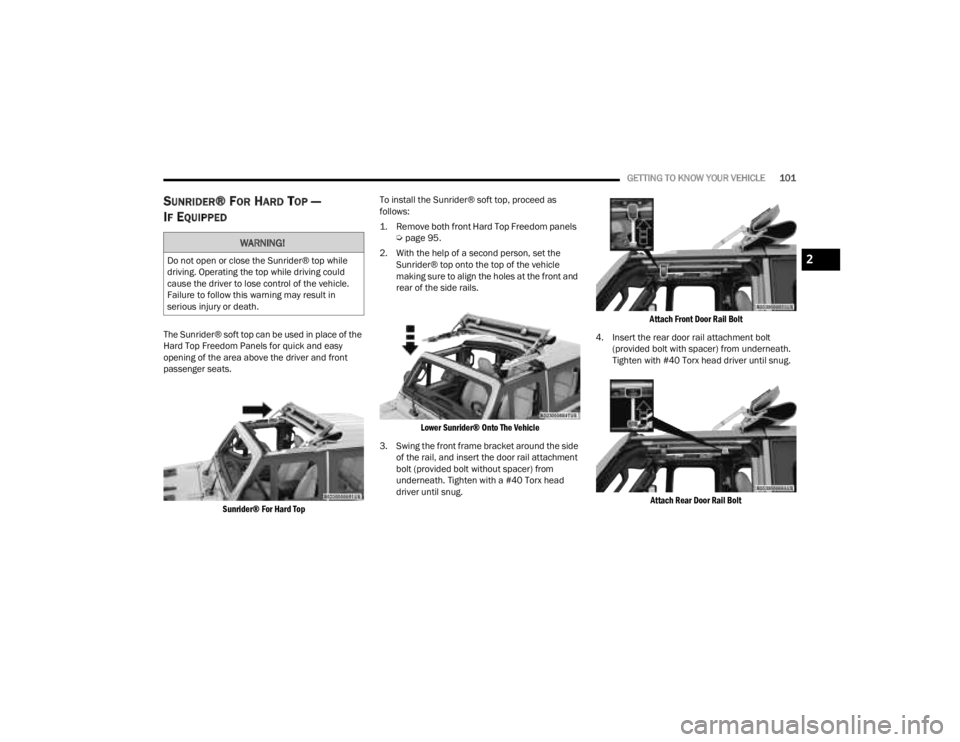
GETTING TO KNOW YOUR VEHICLE101
SUNRIDER® FOR HARD TOP —
I
F EQUIPPED
The Sunrider® soft top can be used in place of the
Hard Top Freedom Panels for quick and easy
opening of the area above the driver and front
passenger seats.
Sunrider® For Hard Top
To install the Sunrider® soft top, proceed as
follows:
1. Remove both front Hard Top Freedom panels
Ú
page 95.
2. With the help of a second person, set the Sunrider® top onto the top of the vehicle
making sure to align the holes at the front and
rear of the side rails.
Lower Sunrider® Onto The Vehicle
3. Swing the front frame bracket around the side of the rail, and insert the door rail attachment
bolt (provided bolt without spacer) from
underneath. Tighten with a #40 Torx head
driver until snug.
Attach Front Door Rail Bolt
4. Insert the rear door rail attachment bolt (provided bolt with spacer) from underneath.
Tighten with #40 Torx head driver until snug.
Attach Rear Door Rail Bolt
WARNING!
Do not open or close the Sunrider® top while
driving. Operating the top while driving could
cause the driver to lose control of the vehicle.
Failure to follow this warning may result in
serious injury or death.2
23_JT_OM_EN_USC_t.book Page 101
Page 106 of 448
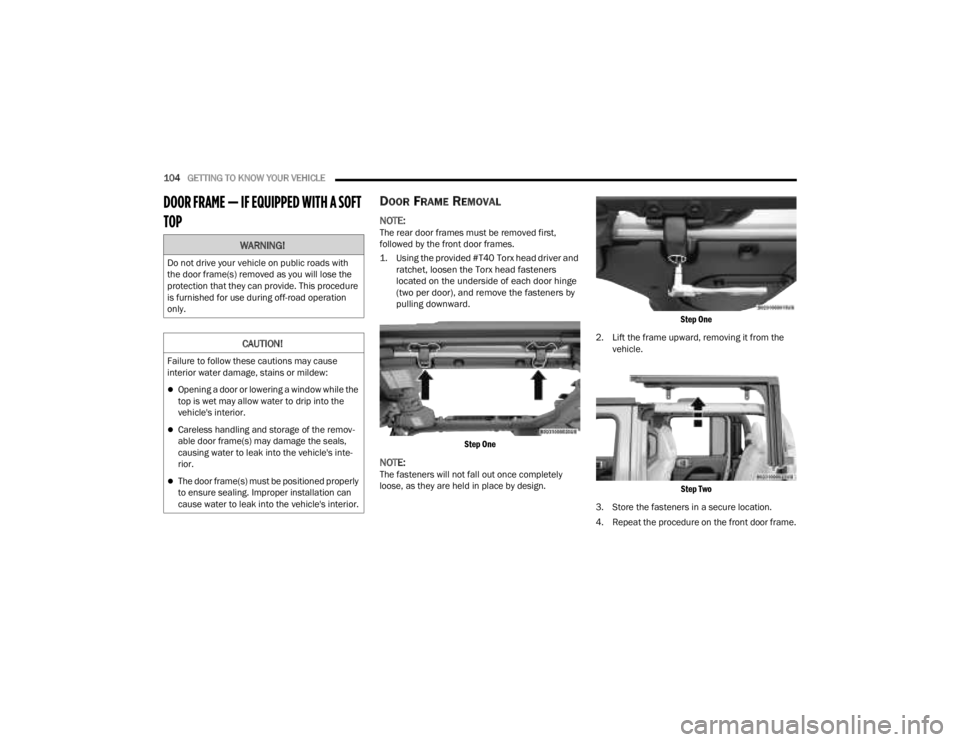
104GETTING TO KNOW YOUR VEHICLE
DOOR FRAME — IF EQUIPPED WITH A SOFT
TOP DOOR FRAME REMOVAL
NOTE:The rear door frames must be removed first,
followed by the front door frames.
1. Using the provided #T40 Torx head driver and
ratchet, loosen the Torx head fasteners
located on the underside of each door hinge
(two per door), and remove the fasteners by
pulling downward.
Step One
NOTE:The fasteners will not fall out once completely
loose, as they are held in place by design.
Step One
2. Lift the frame upward, removing it from the vehicle.
Step Two
3. Store the fasteners in a secure location.
4. Repeat the procedure on the front door frame.
WARNING!
Do not drive your vehicle on public roads with
the door frame(s) removed as you will lose the
protection that they can provide. This procedure
is furnished for use during off-road operation
only.
CAUTION!
Failure to follow these cautions may cause
interior water damage, stains or mildew:
Opening a door or lowering a window while the
top is wet may allow water to drip into the
vehicle's interior.
Careless handling and storage of the remov -
able door frame(s) may damage the seals,
causing water to leak into the vehicle's inte -
rior.
The door frame(s) must be positioned properly
to ensure sealing. Improper installation can
cause water to leak into the vehicle's interior.
23_JT_OM_EN_USC_t.book Page 104
Page 107 of 448
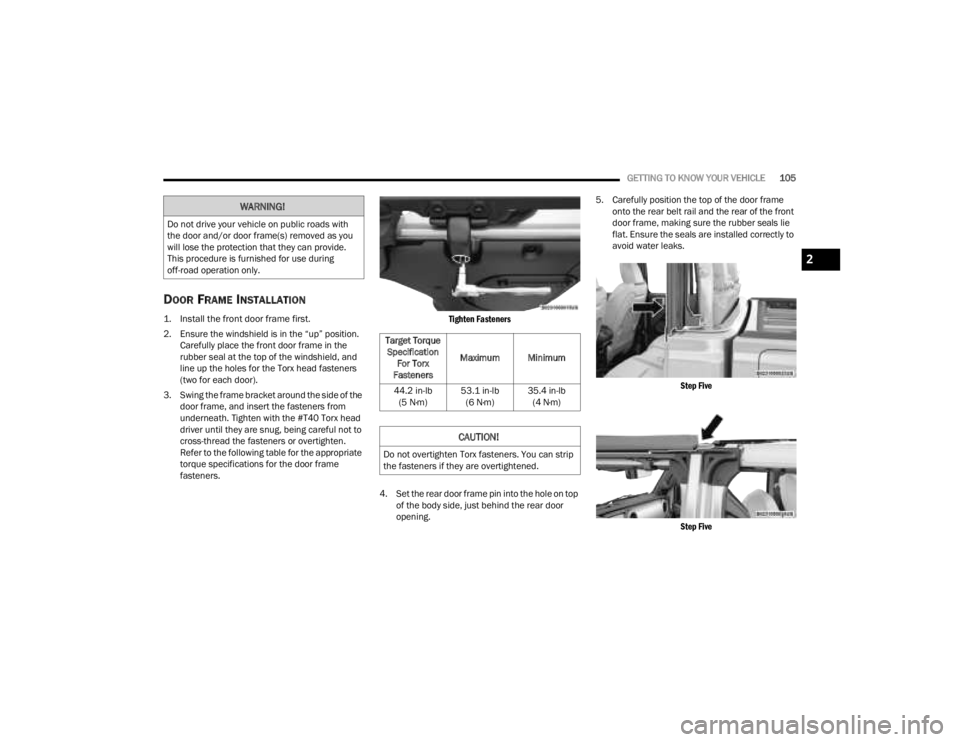
GETTING TO KNOW YOUR VEHICLE105
DOOR FRAME INSTALLATION
1. Install the front door frame first.
2. Ensure the windshield is in the “up” position.
Carefully place the front door frame in the
rubber seal at the top of the windshield, and
line up the holes for the Torx head fasteners
(two for each door).
3. Swing the frame bracket around the side of the door frame, and insert the fasteners from
underneath. Tighten with the #T40 Torx head
driver until they are snug, being careful not to
cross-thread the fasteners or overtighten.
Refer to the following table for the appropriate
torque specifications for the door frame
fasteners.
Tighten Fasteners
4. Set the rear door frame pin into the hole on top of the body side, just behind the rear door
opening. 5. Carefully position the top of the door frame
onto the rear belt rail and the rear of the front
door frame, making sure the rubber seals lie
flat. Ensure the seals are installed correctly to
avoid water leaks.
Step Five
Step Five
WARNING!
Do not drive your vehicle on public roads with
the door and/or door frame(s) removed as you
will lose the protection that they can provide.
This procedure is furnished for use during
off-road operation only.
Target Torque Specification For Torx
Fasteners Maximum Minimum
44.2 in-lb (5 N·m) 53.1 in-lb
(6 N·m) 35.4 in-lb
(4 N·m)
CAUTION!
Do not overtighten Torx fasteners. You can strip
the fasteners if they are overtightened.
2
23_JT_OM_EN_USC_t.book Page 105
Page 108 of 448

106GETTING TO KNOW YOUR VEHICLE
(Continued)
6. Insert the fasteners from underneath. Tighten
with the #T40 Torx head driver until they are
snug, being careful not to cross-thread the
fasteners or overtighten. Refer to the previous
table for the appropriate torque specifications
for the door frame fasteners.
FOLDING WINDSHIELD
The fold-down windshield on your vehicle is a
structural element that can provide protection in
some accidents. The windshield also provides
protection against weather, road debris and
intrusion of small branches and other objects.
Do not drive your vehicle on-road with the
windshield down, as you lose the protection this
structural element provides.
If required for certain off-road uses, the windshield
can be folded down. However, the protection
afforded by the windshield is then lost. If you fold
down the windshield, drive slowly and cautiously. It
is recommended that the speed of the vehicle be
limited to 10 mph (16 km/h), with low range
operation preferred if you are driving off-road with
the windshield folded down. Raise the windshield as soon as the task that
required its removal is completed and before you
return to on-road driving. Both you and your
passengers should wear seat belts at all times,
on-road and off-road, regardless of whether the
windshield is raised or folded down.
LOWERING THE WINDSHIELD
1. Before completing the following steps:
If your vehicle is equipped with a soft top,
the top
MUST be lowered Ú page 83, and
the door frames must be removed
Ú page 104 prior to lowering the wind -
shield.
If your vehicle is equipped with a hard top,
the Freedom Panels MUST be removed
prior to lowering the windshield Úpage 95.
WARNING!
Carefully follow these warnings to help protect
against personal injury:
Do not drive your vehicle on-road with the
windshield down.
Do not drive your vehicle unless the wind -
shield is securely fastened, either up or down.
Eye protection, such as goggles, should be
worn at all times when the windshield is down.
Be sure that you carefully follow the instruc -
tions for raising the windshield. Make sure
that the folding windshield, windshield wipers,
side bars, and all associated hardware and
fasteners are correctly and tightly assembled
before driving your vehicle. Failure to follow
these instructions may prevent your vehicle
from providing you and your passengers’
protection in some accidents.
If you remove the doors, store them outside
the vehicle. In the event of an accident, a
loose door may cause personal injury.
CAUTION!
Failure to follow this step will cause damage to
the vehicle’s header seal.
WARNING!
23_JT_OM_EN_USC_t.book Page 106
Page 110 of 448
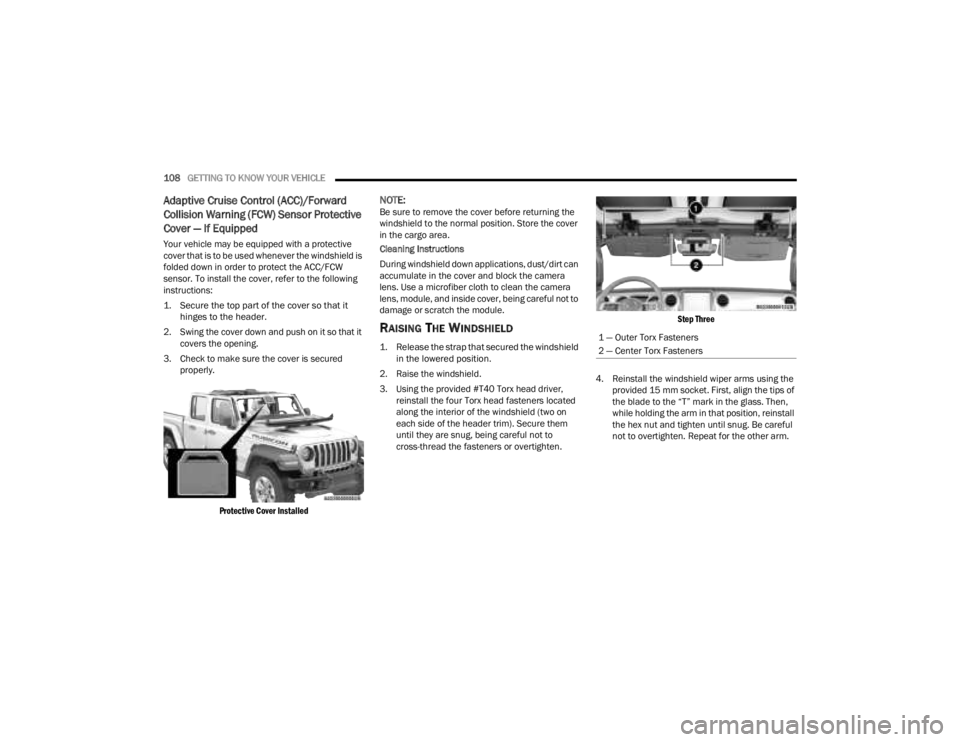
108GETTING TO KNOW YOUR VEHICLE
Adaptive Cruise Control (ACC)/Forward
Collision Warning (FCW) Sensor Protective
Cover — If Equipped
Your vehicle may be equipped with a protective
cover that is to be used whenever the windshield is
folded down in order to protect the ACC/FCW
sensor. To install the cover, refer to the following
instructions:
1. Secure the top part of the cover so that it
hinges to the header.
2. Swing the cover down and push on it so that it covers the opening.
3. Check to make sure the cover is secured properly.
Protective Cover Installed
NOTE:Be sure to remove the cover before returning the
windshield to the normal position. Store the cover
in the cargo area.
Cleaning Instructions
During windshield down applications, dust/dirt can
accumulate in the cover and block the camera
lens. Use a microfiber cloth to clean the camera
lens, module, and inside cover, being careful not to
damage or scratch the module.
RAISING THE WINDSHIELD
1. Release the strap that secured the windshield in the lowered position.
2. Raise the windshield.
3. Using the provided #T40 Torx head driver, reinstall the four Torx head fasteners located
along the interior of the windshield (two on
each side of the header trim). Secure them
until they are snug, being careful not to
cross-thread the fasteners or overtighten.
Step Three
4. Reinstall the windshield wiper arms using the provided 15 mm socket. First, align the tips of
the blade to the “T” mark in the glass. Then,
while holding the arm in that position, reinstall
the hex nut and tighten until snug. Be careful
not to overtighten. Repeat for the other arm.1 — Outer Torx Fasteners
2 — Center Torx Fasteners
23_JT_OM_EN_USC_t.book Page 108
Page 111 of 448
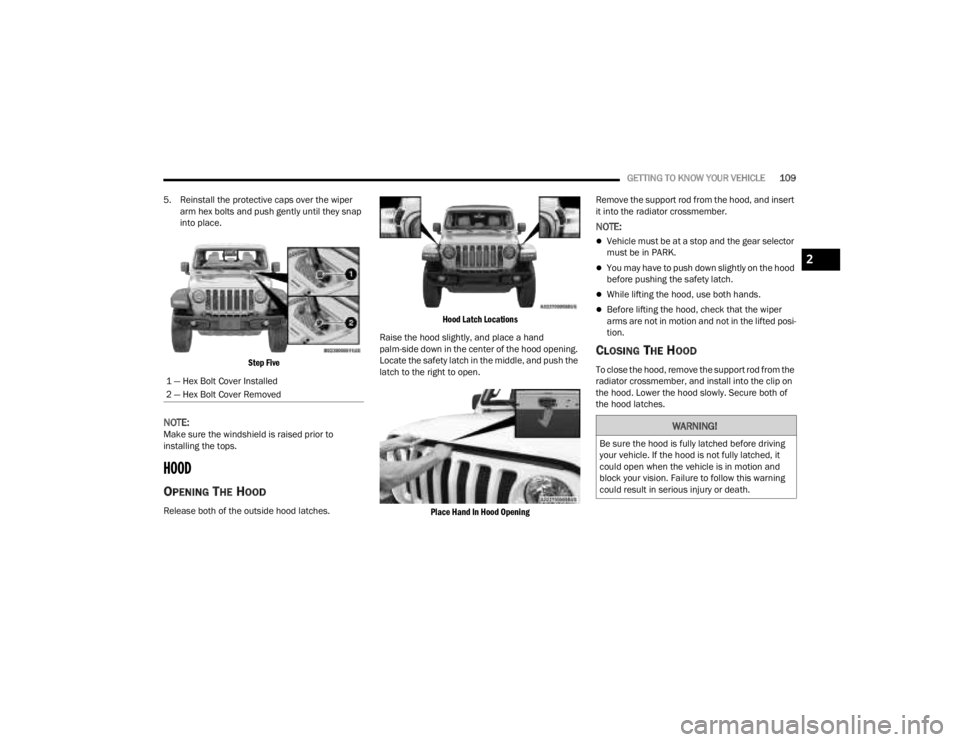
GETTING TO KNOW YOUR VEHICLE109
5. Reinstall the protective caps over the wiper arm hex bolts and push gently until they snap
into place.
Step Five
NOTE:Make sure the windshield is raised prior to
installing the tops.
HOOD
OPENING THE HOOD
Release both of the outside hood latches.
Hood Latch Locations
Raise the hood slightly, and place a hand
palm-side down in the center of the hood opening.
Locate the safety latch in the middle, and push the
latch to the right to open.
Place Hand In Hood Opening
Remove the support rod from the hood, and insert
it into the radiator crossmember.
NOTE:
Vehicle must be at a stop and the gear selector
must be in PARK.
You may have to push down slightly on the hood
before pushing the safety latch.
While lifting the hood, use both hands.
Before lifting the hood, check that the wiper
arms are not in motion and not in the lifted posi
-
tion.
CLOSING THE HOOD
To close the hood, remove the support rod from the
radiator crossmember, and install into the clip on
the hood. Lower the hood slowly. Secure both of
the hood latches.
1 — Hex Bolt Cover Installed
2 — Hex Bolt Cover Removed
WARNING!
Be sure the hood is fully latched before driving
your vehicle. If the hood is not fully latched, it
could open when the vehicle is in motion and
block your vision. Failure to follow this warning
could result in serious injury or death.
2
23_JT_OM_EN_USC_t.book Page 109